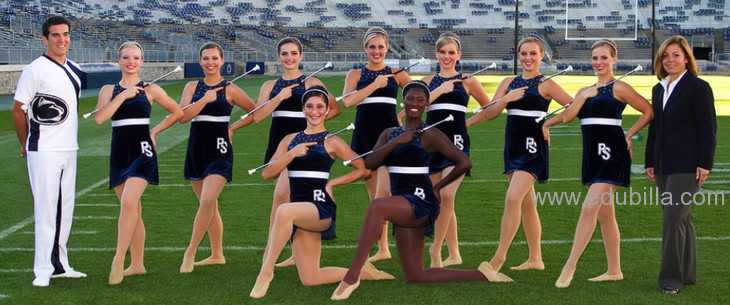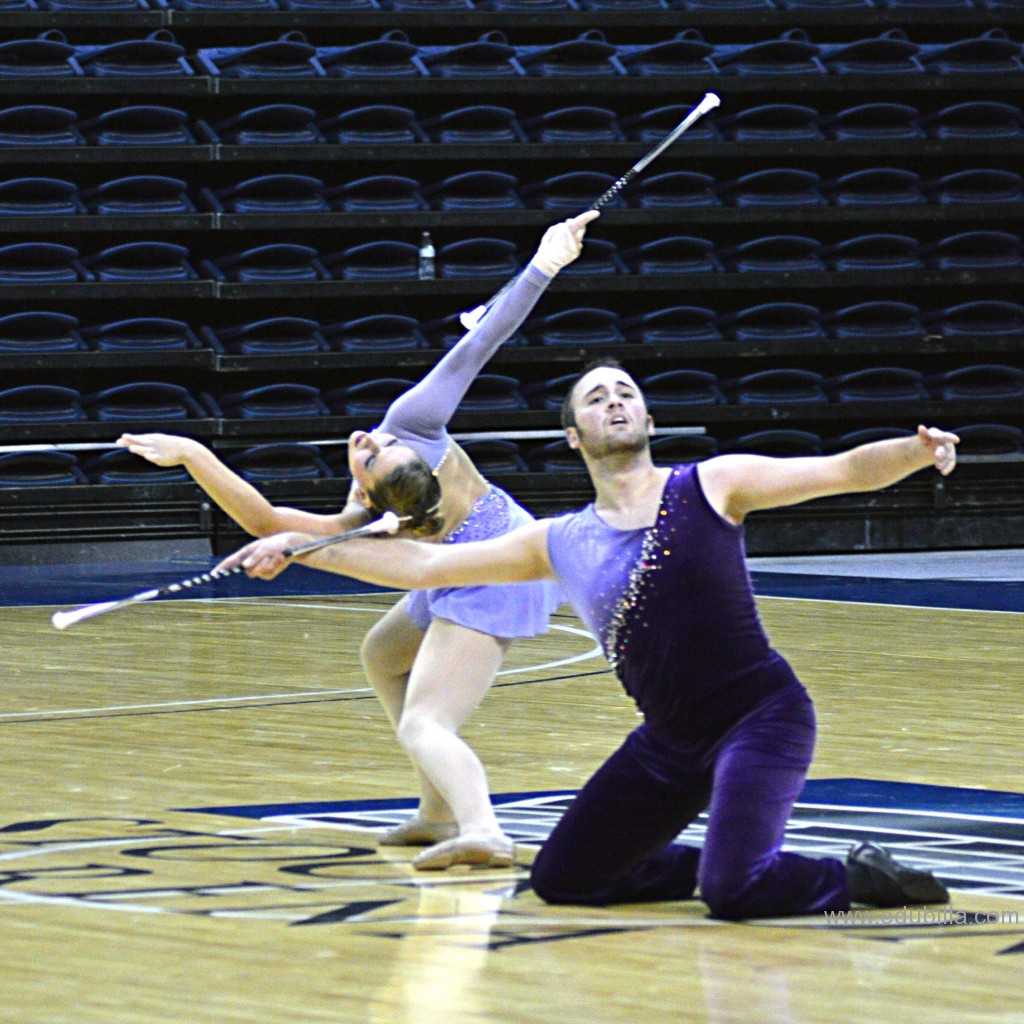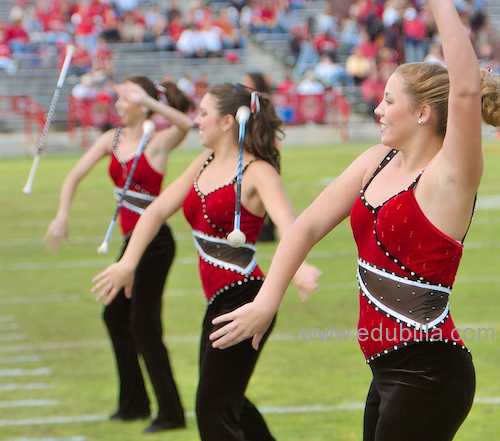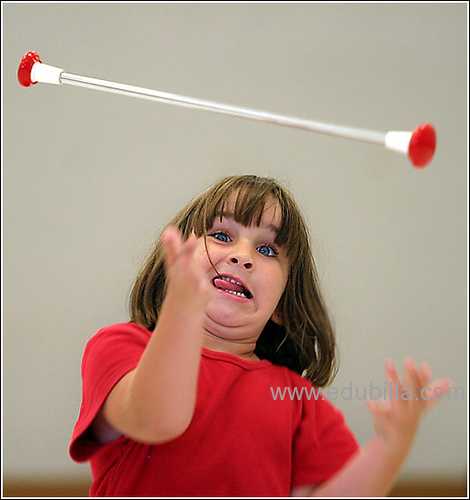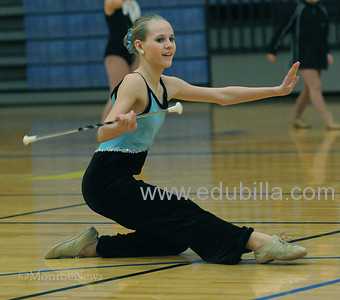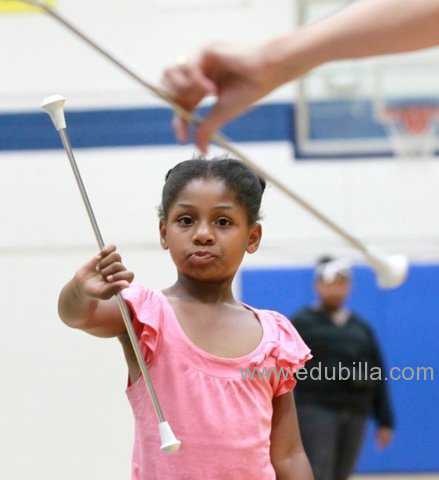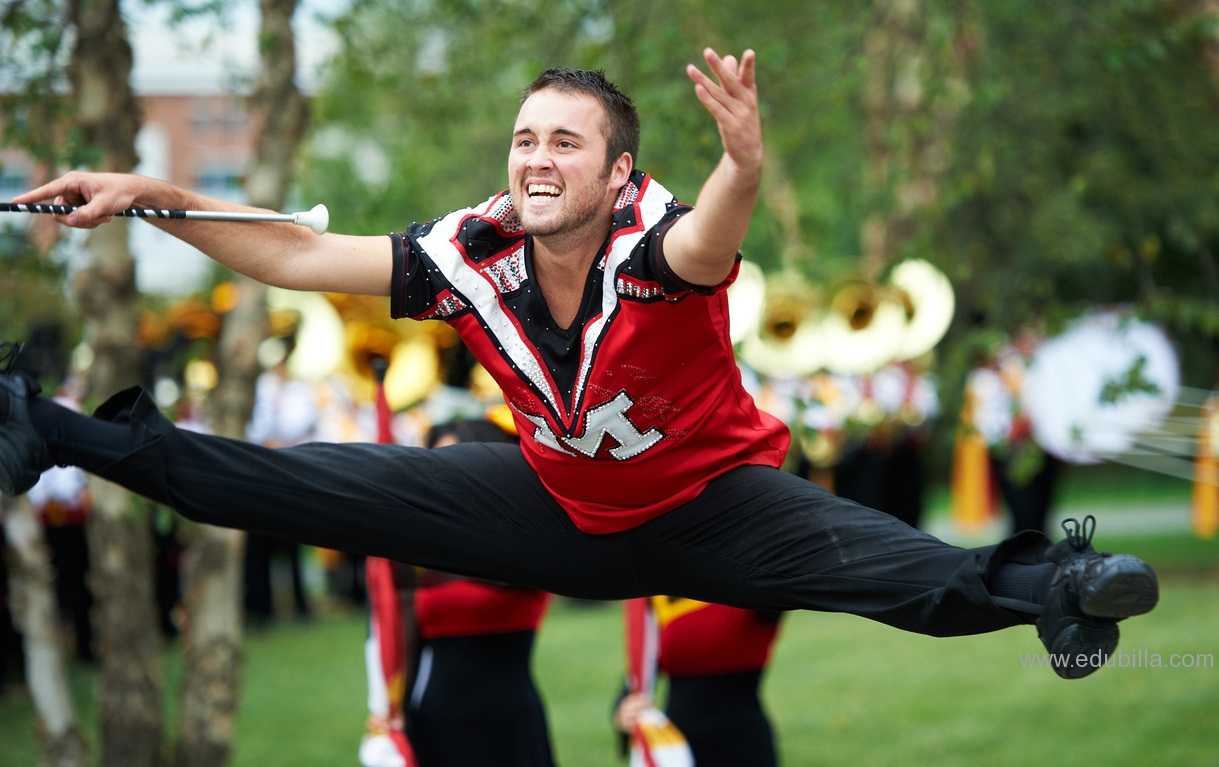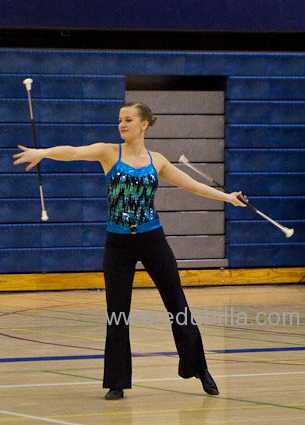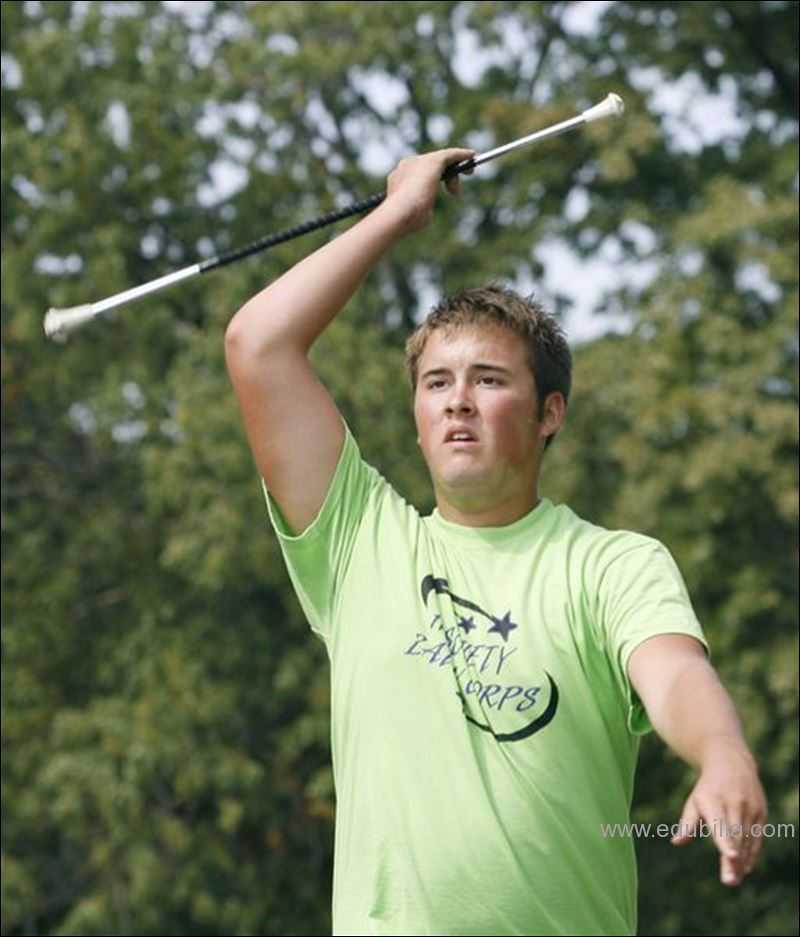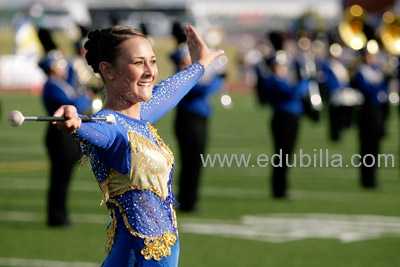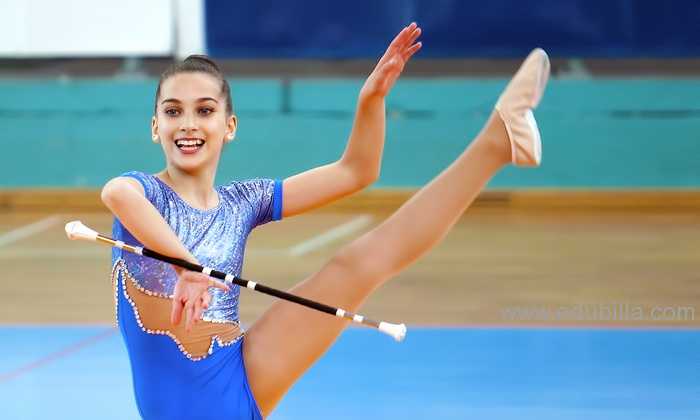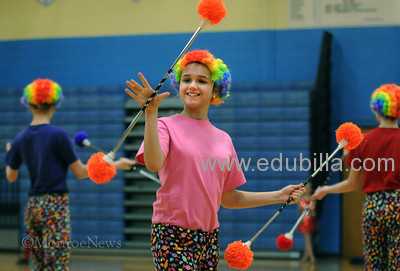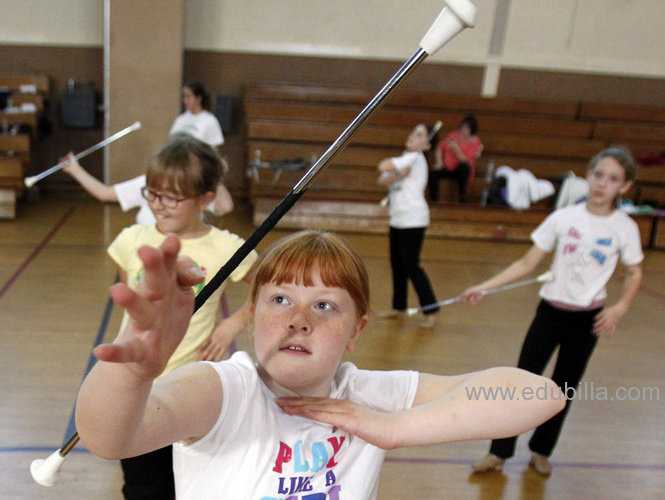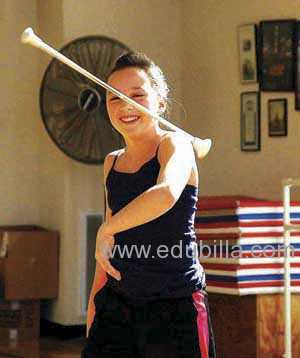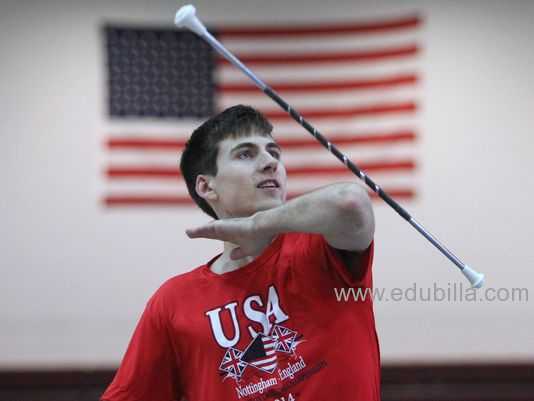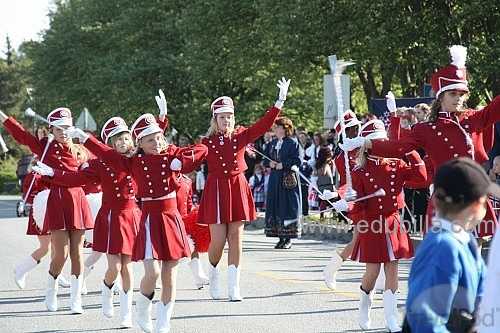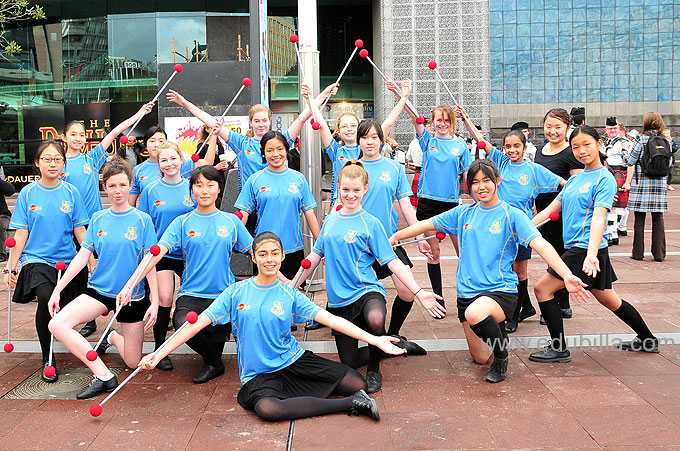
Overview Of Baton Twirling
Baton Twirling is an athletic endeavor enhanced through creativity. It is a challenging sport that combines the skillful mastery of twirling, tossing and catching batons with body movements incorporating dance and gymnastics. Routines are set to an array of musical selections. It is a sport that offers competition oppportunities for both individuals and/or those wishing to participate in teams.
Baton twirling encompasses all aspects of mental and physical well-being. It is a sport for both males and females of all ages. Baton twirling lends to diversity and it's participants reflect the limitless positive attributes it instills.
Events:
The main events at the first World Baton Twirling Championships were Freestyle and Compulsory Moves. Two new events were introduced: Teams (1981) and Pairs (1993). In 2005, a Short Program replaced the Compulsory Moves for the Senior Men and Women’s divisions.
The World Championships have the following events:
Freestyle Senior Women & Men, Junior Women and Men A solo event accompanied by a compulsory/short programme event, strut, solo, dancetwirl, pairs, trios, show choir, 1 baton, 2 baton, 3 baton, teams, and group. Pairs, trios, teams, and show choir can be co-ed, while individual events cannot.
Popularity:
In more recent years, the increasing popularity of the sport brought about the formation of the World Baton Twirling Federation( WBTF), whose purpose is to encourage participation and to standardize the sport. Initial organization was undertaken in London, England in 1977. In 1978, Bylaws and International Rules were accepted in the Canary Islands. The first twirling demonstrations were presented by the WBTF in 1979 in Nice, France. By October 1979, plans were finalized for the first World Championships where ten countries would compete. At this time, Canada was accepted into the WBTF.
Analysis of the Sport:
IT IS PHYSICAL – Baton Twirling requires fantastic coordination of fingers, hands, arms, feet and legs; in addition to extraordinary control of the back, stomach and torso, all of which are called to respond instantly to the sound the ear hears and the sight the eye sees. It requires endurance, agility, strength, and balance.
IT IS PSYCHOLOGICAL – Baton Twirling allows athletes to learn more about confidence and fear, self-esteem and self-image; it gives the chance to realize that attitude is what makes or breaks the competitive spirit, not anyone or anything else. It is a type of mind set with an increased awareness, which challenges an athlete to realize the potential she/he may possess. It requires self-discipline.
IT IS EMOTIONAL – Baton Twirling provides guided social interaction with other athletes. It offers the opportunity to participate and have fun in a healthy, wholesome activity and to develop lasting friendships. It provides the chance to recognize excellence and beauty, to be sensitive, to develop good character, and to have great youthful memories that last a lifetime.
IT IS A SCIENCE – Baton Twirling is exact, and demands precise execution. The baton is always pushing the laws of physics with force and speed, action and reaction, velocity and relativity.
IT IS AN ARTISTIC SPORT – Baton Twirling requires the courage of a hockey player (without the padding), the concentration of a sprinter, the quick reactions of a boxer, and the stage presence and grace of a figure skater.
IT IS EDUCATIONAL – Baton Twirling allows our youth to learn how to take all of these elements, some dry and technically tiresome, some difficult and challenging, and create emotion, feeling, passion, develop a good work ethic, understand their own inner strengths and weaknesses, learn how to work with others and find a reason to stay focused on a quality life.
Game Rules
SOLO TWIRLING
One baton only, entrance and exit are optional. Gymnastics moves are permitted.
Ages: 0-6, 7-8, 9-11, 12-14, 15+over
Timing begins with opening salute and stops with ending salute. Time Limits:
- Level 1 (Special Beginner): 1:00-2:00
- Levels 2 & 3 (Novice & Beginner): 1:30-2:00
- Level 4 (Intermediate): l:30-2:15
- Level 5 (Advanced): 2:00-2:30
To protect the integrity of the developmental levels of twirling, the following restrictions apply to twirls allowed at each level:
Level 1 (Special Beginner), No more than a 1 turn and 2 consecutive elbow rolls; no high toss tricks with illusions or gymnastics moves underneath.
Level 2 (Novice): No more than a 2 turn and no more than 4 continuous elbows.
Level 3 (Beginner ): No more than a 3 turn and 6 continuous elbows
Level 4 (Intermediate): No more than a 4 turn and 8 continuous elbows.
BOYS/MENS SOLO
Ages: 0-8, 9-11, 12-14, 15& over Time Limit: l:30 - 2:30
Score Sheet and Penalties Same as Solo Twirling
FEATURE TWIRLER SOLO
Open to any twirler age 15+. Can do any combination of one baton and novelty. Performed to standard march music. Timing begins and ends with salute. Time limit 2:00 to 2:30 minutes. One baton minimum of 1 minute
DRESS MODEL
No specific pattern is required. The contestant must complete the modeling in 1 ½ minutes. Any time spent on the floor in excess of this will result in .1 penalty per second. No specific dress type or length is required. Music provided by TU.
COSTUME MODEL (formerly Best Appearing)
Same as modeling, but in a costume. Baton is optional – time is 1½ minutes Max.
BASIC MARCH
Basic marching in a square either singly or follow-the-leader (judge's discretion). Contestants are evaluated on posture, leg lines, carriage, with a particular emphasis on timing. If no one in the division remains in step for an entire square, no first place will be given. Awards in this case will be given beginning with second place.
Baton not required, may carry poms, rifle, sabre, etc.
SPECIAL BEGINNER BASIC MARCH (offered at some competitions)
Same rules as Basic March; for contestants who have never won 1st place in a Basic March event. Baton not required, may carry poms, rifle, sabre, etc.
MILITARY MARCH
Marching to be performed in a square, straight line or "L". Contestants must demonstrate an ability to beat time. Judging is on posture, bearing, leg lines with a particular emphasis on timing. No penalty or extra credit for variations. If no one in the division remains in step for an entire square, no first place will be given. Awards in this case will be given beginning with second place.
FANCY STRUT
Rules for Beginner, Intermediate and Advanced levels are the same. There are no pattern requirements for Strut; it may be in a T, a straight line, free style, super X or any other pattern. Judging will be based on excellence within the style.
Penalties:
- drop .5
- slip .1
- overtime .1 per second
- fall .5
- out of step .5/8 counts
2 BATON
Timing begins with opening salute of at least one baton and stops with ending salute of at least one baton. Time Limit for all levels: 1:30-2:00
3+ BATON
Timing begins with opening salute of at least one baton and stops with ending salute of at least one baton.
4 baton permitted as a portion of routine, if desired. Time limit for all levels: :30 – 2:00
SHOW ROUTINE (SOLO or DUET)
Show Routine is performed to music of contestant's choice. Use of any type of twirling apparatus, multiple batons and novelty equipment with dance moves is permitted. One baton twirling should be a portion of routine, but use of novelties is expected. Time limit for all ages is 1:30 to 3 minutes. No salute is required. Timing will begin and end with the music. Each contestant must have music marked with their name and ready to play. If music stops or has technical difficulty for any reason after the first 15 seconds, contestant may not start over. Contestants are encouraged to bring their own CD player as backup in case of technical difficulties. Props may be used but no other persons may appear on "stage" during the routine.
Penalties:
- 1 per sec under and over time
- 5 drop
- 1 break
- 5 fall
SOLO DANCE TWIRL
One baton only – no novelties or props. Performed to music of contestant’s choice. Score sheet & penalties same as Show Routine. Time Limit: 1:30- 3 minutes.
DUET TWIRL
Two contestants compete together with one baton each. Standard march music. Division determined by averaging ages: 0-8.5, 9-11.5, 12-14.5, 15+ over. Timing begins & ends with a salute. Time Limit: Beginner: 1:30-2:00 Advanced: 2:00-2:30
DUET STRUT
Two contestants only. Use own music. Floor pattern: down the length of the gym once or re-traced line; oblique moves are permitted. Time limit: 1:00 – 3:00
Timing begins and ends with music.
Avg. Ages: 0-8.5, 9-11.5, 12-14.5, 15+
POM SOLO or DUET
Use own music. Time Limit: Max. 1 ½ minutes; timing begins and ends with music. No equipment other than poms. Ages 0-8, 9-11, 12-14, 15+ (Avg. ages for duet)
RIFLE or COLOR GUARD (SOLO or DUET)
Use own music
Time Limit: Maximum of 3 minutes; timing begins & ends with music.
Ages: 0-8, 9-11, 12-14, 15 + over (Avg. ages for duets)
RATING FESTIVAL
This event is designed for twirlers new to competition. This is an opportunity for Level 1 twirlers (Special Beginner) to perform for a minimal cost. They are not judged on a comparison basis, but rather against a standard. Therefore, there are no placements, but upon completion of performance each twirler is given a rating ribbon reflecting the quality of the performance. Ribbons are: Excellent, Very Good, Good, Fair, Participant.
SCORE SHEET ONLY
Twirling for "Score Sheet only" is permitted, if designated before performing. Twirler will then perform in front of the same judge as her division, but she will receive comments only - no scores and no awards. Twirling for score sheet only does not constitute "competing" and therefore does not qualify one for twirl-off, high point or pageants. Score Sheet Only not permitted at TU Internationals.
PARADE MARCH (offered on a limited basis at specific competitions)
Parade March is performed in a straight line covering a distance of 100 feet to be completed in one minute. There is no penalty for oblique moves, hesitations or backsteps. Standard march record; only one baton may be used. Timing starts with the first movement and ends when the twirler crosses the 100 foot mark or ending pose (whichever is first). Failure to cross the finish line within 60 seconds means a .5 penalty. All judging and penalties will stop after 1 minute or when the line is crossed, whichever comes first. Penalties: drop .5 out of step .5
BASIC TWIRL SOLO
This is a prescribed routine designed for beginning twirlers. Contestants are judged on accuracy of twirls plus speed, smoothness and showmanship. This event is only open to Level 1 and Level 2 (Special Beginner and Novice) twirlers. Competition in Basic Twirl Solo is offered at all TU contests. Penalties: same as solo twirling
BASIC X STRUT
This is a prescribed strutting routine designed for beginning strutters. Contestants are judged on the accuracy of the routine, in addition to body form, timing and showmanship. Penalties: same as Fancy Strut
A copy of the Basic X Strut or Basic Twirl Solo may be obtained by sending a self-addressed, stamped envelope to TU Headquarters or online at www.twirlingunlimited.com. In addition an instructional DVD of these two routines and other teaching information is available for purchase. Write: TU, 700 Ghent Rd. , Akron , OH 44333.
Equipments Need For Baton Twirling
- Twirling batons
- Bags and cases
- Kids twirling batons
- Fire and novelty batons
- Dance streamers and flags
- Fire and novelty batons
- Baton twirling uniforms
History Of Baton Twirling
The history of baton twirling is sketchy, most of it deriving from guess or hearsay, and its actual origin is unknown. The most popular guess is that it is related to the colorful Swiss flag swinging which came to this country along with the Dutch when they settled in Pennsylvania. Another is that it originated at Millsaps College in Mississippi. Here, shortly after the Civil War, the well-known Major Millsaps founded a college. His "lady athletes" were called the Majorettes, and it is possible that this is the origin of our present-day high-stepping majorette's name.
Baton twirling began in Eastern Europe & Asia. At first people used knives, guns, torches, and sticks. The armies began to twirl rifles, and when the soldiers were marching there would be a rifle twirler in the front. It became more popular when WWII was over in the U.S.
Batons formed:
When people would use maces to twirl it would be very hard to control since one side is so much heavier then the other. The baton was created to be used instead of a mace.The baton is hollowed light metal with two ends to even out the weight of the baton.
Associations:
In the 1930's there was more people started to become majorettes. A majorette is the leader/baton twirler that leads the band. In the 1950's more baton twirling associations began. Two of the associations that started is the USTA short for United States Twirling Association and the National Baton Twirling Association known as the NBTA. In 1977 the WBTF (world baton twirling federation) was created. All of these were and still are major organizations for baton twirling.
The 1st showing:
The first World wide demonstration of baton twirling took place in Venice Italy. This event took place on March 31, 1979 more then 10,000 people viewed this event.
Origin Of Baton Twirling
Baton twirling first originated in Eastern Europe and Asia. Back then it was mainly displayed in dance festivals where knives and guns were also twirled. Rifle twirling then became popular in the military. In the United States during WWII the rifle was switched out for a "mace" which is much like a large baton and usually used by a drum major. After the war the interest in twirling increased and focused more on parades and entertainment rather than in the military.
Theories:
- There are a number of theories about the origin of baton twirling. One theory suggests the original baton was a long stick used by the conductor of an orchestra, band, or chorus. The conductor's long baton led to the drum major's shorter and lighter baton, which he used to twirl and toss to entertain the listening audience. From this came the modern baton.
- Another theory suggests twirling originated with the Hawaiians who twirled flaming torches or sticks. Yet another theory suggest that twirling could have developed from the Samoan sword spinners. One last theory suggests it originated for the Southern Minstrel Dancers of years ago who used canes to dance with, often twirling the cane as part of the routine.
- Whatever the theory, baton twirling has developed into a sport which combines dance and gymnastic techniques with baton twirling skills, and provides both girl and boy athletes with opportunities to develop a variety of skills.
United States Twirling Association (USTA):
The United States Twirling Association (USTA) was founded in 1958 and was the first twirling association to be be run democratically. They elect their members through membership, and are still today the only twirling association to do so.
Competitions:
The USTA was first created to design a system for competitions. They use the Olympic Scoring System for judging. They hold state, regional and national competitions. They also distribute their own competition music. In 1974 competing in USTA competitions became available for all ages.Dance twirl and three-baton were incorporated into competitions in 1976. Today what the USTA's goal is is to provide opportunities for members to participate in twirling recreationally and competitively.
First World Championship:
The first World Baton Twirling Championships were held in 1980 in Seattle, Washington, USA with athletes from ten countries of the World Baton Twirling Federation competing in three divisions: Junior Women, Senior Women and Men.
At this event, all three World Champions represented the United States of America:
- Junior Women: Bonnie Palacious
- Senior Women: Pam Harris
- Men: Michael Cruz
Governing Bodies
World Baton Twirling Federation (WBTF):
Established in 1977, the World Baton Twirling Federation was formed to develop, encourage, and standardize the sport. In October 1979, the Federation representatives met in Paris, France to finalize all plans for the first World Championships, bringing together teams of twirlers from ten countries to compete in a spirit of healthy, athletic competition. The United States Twirling Association, Inc. hosted the first World Championships in Seattle, Washington in 1980. Each successive year, one member country has hosts the championships in August.
History:
Information about the origins of the sport, the WBTF and the first World Championships held in Seattle in 1980.
Founders:
Recognition of the individuals that were instrumental in creating the World Baton Twirling Federation and the sport as it now exists.
The Sport:
An explanation and analysis of Sport Baton Twirling.
Athletes:
Recipients of the WBTF Special Athlete's Award of Recognition.
Certified judges and Clinicians:
Judges and Clinicians that have been certified by the World Baton Twirling Federation.
In Memoriam:
Recognition of deceased individuals that have made major contributions to the sport.
Honorary Members:
Current member countries of the WBTF include: Australia, Belgium, Brazil, Canada, Catalonia, Croatia, England, France, Germany, Hungary, Ireland, Italy, Japan, Netherlands, Norway, Scotland, Seychelles, Slovenia, South Africa, Sweden, Switzerland and the United States of America.
To Visit WBTF Click Here
World Twirling Association (WTA):
In 1960, Victor Faber founded the World Twirling Association. He left his mark on the sport of baton twirling by founding TWO twirling organizations and for being the only person in his field to lead a twirling organization who had been a championship baton twirler.
Mr. Faber retired in 1980 and since then, Nancy Hespe has been the director of the organization. Prior to that time, she had twirled, taught, and judged for Victor. So she had the perfect background to head up the World Twirling Association for the next twenty years . . . and still counting!
To Visit WTA Click Here
Awards Related To Baton Twirling
Lynda Garland Award:
The Lynda Garland "Award For Excellence" is presented to a Coach who exemplifies excellent progressive coaching, superior technical abilities and provides innovative ideas and programs.
Saskatchewan Baton Twirling Association Awards:
categories:
- Athlete of the Year
- Level A All-Around Award of Excellence
- Pair of the Year
- Team of the Year
Sample Documents Of Baton Twirling
-Andre Agassi


